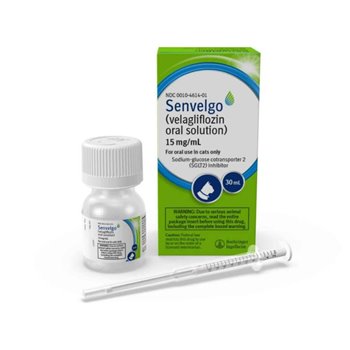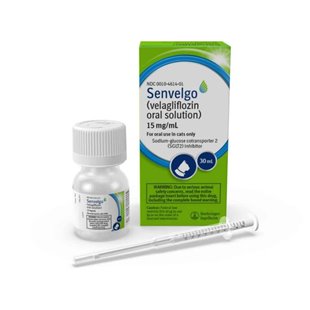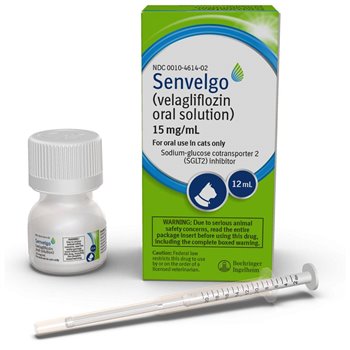Senvelgo for Cats - The Latest Treatment for Feline Diabetes
Senvelgo for Cats is a prescription oral liquid medication used to treat diabetes mellitus in cats. It contains the active substance velagliflozin, a selective sodium-glucose co-transporter 2 (SGLT2) inhibitor. Senvelgo is administered once daily by mouth and is designed to help reduce blood glucose levels in diabetic cats without the need for insulin injections.
Senvelgo is a significant advancement in the management of feline diabetes. It provides an alternative to traditional insulin therapy and may be suitable for certain cats diagnosed with stable diabetes mellitus. It is currently the only veterinary-approved SGLT2 inhibitor specifically formulated for cats.
Senvelgo is available by prescription only (POM-V) and must be used under the supervision of a veterinary surgeon. It is available as 12ml Senvelgo and 30ml Senvelgo
Diabetes in Cats
Diabetes mellitus is a common endocrine disorder in cats, particularly in middle-aged and older cats. It occurs when the cat’s body is unable to produce enough insulin or when the body’s cells fail to respond effectively to the insulin that is produced. Insulin is vital for regulating how the body uses glucose as energy. When insulin function is impaired, glucose remains in the bloodstream instead of being used by cells.
Common signs of diabetes in cats include increased thirst, frequent urination, weight loss despite normal or increased appetite, lethargy, and changes in coat condition. Some cats may also develop weakness in the hind legs, which can affect walking. These signs typically develop gradually, which means they can be overlooked in the early stages. Veterinary examination and blood testing are required to diagnose the condition accurately.
Diabetes is a long-term condition, but it can be effectively managed with appropriate treatment. The goals of treatment are to regulate blood sugar, support healthy weight, maintain hydration, and reduce the risk of complications such as ketoacidosis or nerve damage. A combination of medication, diet, weight control, and routine monitoring forms the foundation of a stable diabetes management plan.
For many years, insulin injections have been the standard treatment for feline diabetes. While insulin is effective, it can be difficult for some cat owners to administer consistently. Cats may also show variable responses to insulin, requiring frequent adjustments. Senvelgo introduces an alternative approach that can be used for certain diabetic cats, and its mode of action makes it a significant development in feline diabetes care.
How Senvelgo Works
Senvelgo contains velagliflozin, a member of the SGLT2 inhibitor class of drugs. Unlike insulin, which lowers blood glucose by enhancing its uptake into cells, velagliflozin works by increasing the excretion of glucose in the urine. SGLT2 proteins are located in the kidneys and are responsible for reabsorbing glucose back into the bloodstream.
Velagliflozin selectively blocks these transporters, reducing the amount of glucose reabsorbed and increasing its elimination through urine. This helps reduce and stabilise blood glucose levels, even in cats with insulin resistance.
Senvelgo is administered once daily by mouth as a flavoured liquid, offering a non-invasive and needle-free treatment option. It does not require injection and does not depend on the cat’s insulin production, making it suitable for stable diabetic cats under veterinary supervision. The use of Senvelgo allows for a simplified treatment regimen and may improve both owner compliance and quality of life for diabetic cats who respond appropriately to the therapy.
Benefits of Senvelgo
- Oral liquid formulation for easy, once-daily administration
- Reduces blood glucose without requiring insulin injections
- First licensed SGLT2 inhibitor for use in cats
- Helps reduce polyuria, polydipsia, and weight loss associated with diabetes
Senvelgo is only indicated for use in stable diabetic cats and may not be suitable for cats with poorly regulated or unstable diabetes. It is important to note that it does not replace insulin in all cases, and its suitability should be determined by a vet based on blood glucose levels, general health, and other clinical factors.
Dosage and Administration
Senvelgo is supplied as a 4mg/ml oral solution, provided in a bottle with a dosing syringe for precise administration. The recommended starting dose is 1mg/kg bodyweight, given once daily.
Senvelgo should be given directly into the mouth using the syringe provided. It can be given with or without food. The bottle must be shaken well before use, and the dose should be measured accurately according to the veterinary prescription.
Monitoring is essential when starting treatment with Senvelgo. Vets will typically recommend follow-up visits to evaluate blood glucose levels, urine glucose, body weight, and overall response to treatment.
Cats receiving Senvelgo should have regular access to fresh water, as the increased loss of glucose through the urine may cause increased thirst and urination in the early stages.
Safety and Precautions
Senvelgo should only be used in cats that have been thoroughly evaluated by a vet. It is not suitable for use in the following situations:
- Cats with type 1 diabetes or diabetic ketoacidosis (DKA)
- Cats with severe kidney disease or dehydration
- Cats that are pregnant or lactating
- Kittens under 6 months of age
The most common side effects may include:
- Increased urination (polyuria)
- Increased thirst (polydipsia)
- Mild weight loss
- Occasional gastrointestinal upset
In rare cases, more serious adverse effects may occur, such as dehydration or urinary tract infections.
Cats should be monitored for changes in appetite, energy levels, and urination habits. Any signs of illness, vomiting, or collapse should be reported to the vet immediately. Senvelgo must be stored at room temperature and kept out of reach of children and other animals. Unused or expired medication can be returned to us for safe disposal.









